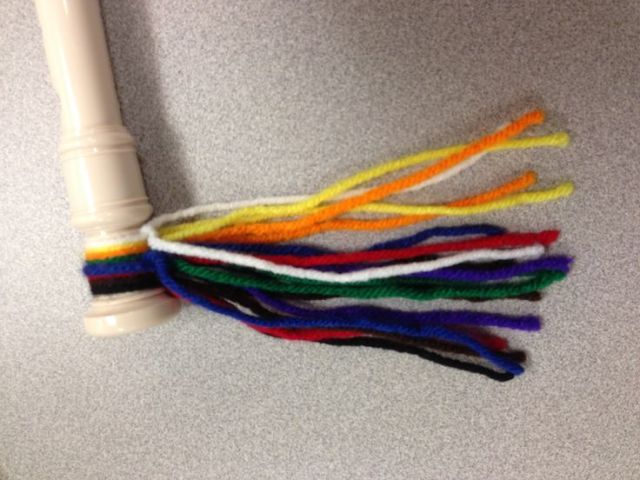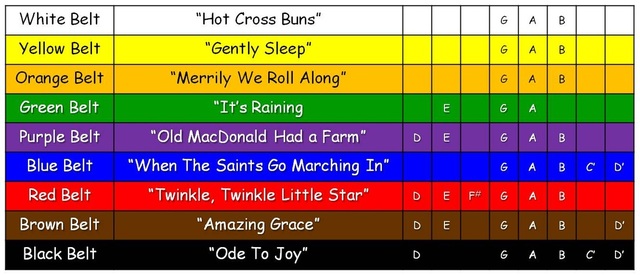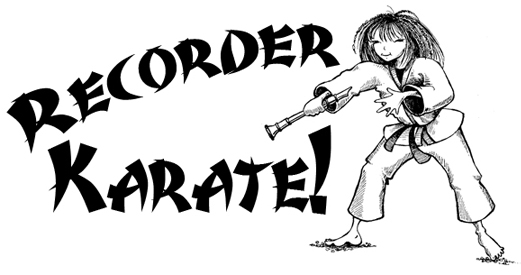What was your the music education experience in elementary school like? When you hear “elementary school music class,” what comes to mind? What images pop up in your head? When I think about my own elementary school music experience, this is what inevitably comes to mind:
That’s right — I’m talking about Recorder Karate.
For those of you who have no idea what I’m talking about, the above image might be very confusing to you.
In a nutshell, Recorder Karate is a way to incentivize students to learn, practice, and play a myriad of songs on the recorder through the acquisition of “belts” (a.k.a. pieces of yarn). When you successfully perform a song for your music teacher, you receive a “belt” to tie to the bottom of your recorder. The songs get exceedingly difficult as you advance — and the belts change in color to reflect that.
The image I have included below is a great example of how one goes through songs for Recorder Karate. Similar to the range in belts associated with Karate itself, those who pass the first task (“Hot Cross Buns”) will receive a white belt and those who pass the most difficult task (“Ode to Joy”) will receive a black belt.
In the case of my elementary school, once students received their black belt in Recorder Karate, they had the opportunity to receive beads for the completion of even more difficult songs.
Arizona’s Centerra Mirage STEM Academy provides an excellent overview of Recorder Karate and how it is implemented in their classroom, including an outline for out-of-classroom practice expectations:
“Students are to turn in a practice record at the end of their music week with me. They are due on Friday, and are NOT ACCEPTED LATE. Students will be given a practice record. In order to turn in their record for credit, they must do the following:
• Practice AT LEAST 10 minutes, 4 DAYS A WEEK
• Parents or guardians MUST sign the form for students to receive credit
• Turn it in WITH PARENT AND STUDENT SIGNATURE- regardless of how much time student has practiced
• If students forget to take a practice record, they may create their own on their own half sheet of paper.
• Turn the record in on Friday in the designated basket.”
Like this elementary school, I was required to practice my recorder outside of the classroom and had to provide documentation to prove it.
Centerra Mirage STEM Academy also explains what each recorder belt symbolizes to get students even more motivation to accumulate them. Here are some of my favorite descriptions:
“White Belt: White signifies a birth, or beginning, of a seed. A white belt student is a beginner searching for knowledge of the art.
Orange Belt: Orange represents the growing power of the sun as it warms the earth to prepare for new growth in the spring. The student is starting to feel their body and mind open and develop.
Red Belt: Red signifies the red-hot heat of the sun. A red belt student acquires more detailed knowledge, they learns to be more cautious with his knowledge and physical abilities. Red is a sign of danger, and the red belt is beginning to become dangerous with their knowledge and abilities.
Brown Belt: Brown represents the ripening of the seed. A brown belt is an advanced student whose techniques are beginning to mature, and he is beginning to understand the fruits of his hard work as a beginner.
Black Belt: Black signifies the darkness beyond the Sun. A black belt seeks new, more profound knowledge of the Art. As he begins to teach others, he plants new seeds and helps them grow and mature.”
For me and my peers, Recorder Karate was a fun way for us to fully immerse ourselves in music education in a way that incentivized us to succeed. It was during Recorder Karate that I realized how much I enjoyed playing musical instruments — which led me to pick up the flute in middle school.
Did your elementary school utilize the Recorder Karate program? If so, what was your experience like?




Katelyn, I read this post and laughed as I immediately flashed back to my experiences playing the recorder and earning strings, similar to the picture in this post. Though I have never been musically inclined, I remember being extremely competitive when it came to earning the most strings in my class. My teacher would give us a list of songs corresponding with “belt” colors and we would be required to learn the song and then individually play it in front of her (missing minimal notes) and if we “passed” the test, we would get a new string to tie on. These strings were a social standard at the time and my classmates and I admired the few students who made it up to the brown and black levels.
I really appreciate the points you make about music education it’s importance within our schools as I’ve always questioned why the recorder is the go-to instrument. I have not played the recorder since 5th grade and while I enjoyed playing at the time, I believe that I may have benefitted more from learning the basics of an instrument that I could have continued playing through my life, such as the piano. I love that children over 10 years later still learn how to play the recorder but wonder if there is the potential to teach children to play more applicable instruments that they may be able to use in the future or even translate to their middle/high school bands? Thank you for sharing, I enjoyed reminiscing on my beloved recorder!
LikeLike